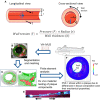Plaque Structural Stress: Detection, Determinants and Role in Atherosclerotic Plaque Rupture and Progression
- PMID: 35872913
- PMCID: PMC9300846
- DOI: 10.3389/fcvm.2022.875413
Plaque Structural Stress: Detection, Determinants and Role in Atherosclerotic Plaque Rupture and Progression
Abstract
Atherosclerosis remains a major cause of death worldwide, with most myocardial infarctions being due to rupture or erosion of coronary plaques. Although several imaging modalities can identify features that confer risk, major adverse cardiovascular event (MACE) rates attributable to each plaque are low, such that additional biomarkers are required to improve risk stratification at plaque and patient level. Coronary arteries are exposed to continual mechanical forces, and plaque rupture occurs when plaque structural stress (PSS) exceeds its mechanical strength. Prospective studies have shown that peak PSS is correlated with acute coronary syndrome (ACS) presentation, plaque rupture, and MACE, and provides additional prognostic information to imaging. In addition, PSS incorporates multiple variables, including plaque architecture, plaque material properties, and haemodynamic data into a defined solution, providing a more detailed overview of higher-risk lesions. We review the methods for calculation and determinants of PSS, imaging modalities used for modeling PSS, and idealized models that explore structural and geometric components that affect PSS. We also discuss current experimental and clinical data linking PSS to the natural history of coronary artery disease, and explore potential for refining treatment options and predicting future events.
Keywords: atherosclerosis; computational modeling; intravascular imaging; plaque rupture; plaque structural stress.
Copyright © 2022 Gu and Bennett.
Conflict of interest statement
The authors declare that the research was conducted in the absence of any commercial or financial relationships that could be construed as a potential conflict of interest.
Figures

Similar articles
-
Plaque Structural Stress Estimations Improve Prediction of Future Major Adverse Cardiovascular Events After Intracoronary Imaging.Circ Cardiovasc Imaging. 2016 Jun;9(6):e004172. doi: 10.1161/CIRCIMAGING.115.004172. Circ Cardiovasc Imaging. 2016. PMID: 27307548
-
Heterogeneity of Plaque Structural Stress Is Increased in Plaques Leading to MACE: Insights From the PROSPECT Study.JACC Cardiovasc Imaging. 2020 May;13(5):1206-1218. doi: 10.1016/j.jcmg.2019.05.024. Epub 2019 Jul 17. JACC Cardiovasc Imaging. 2020. PMID: 31326476 Free PMC article.
-
Plaque Rupture in Coronary Atherosclerosis Is Associated With Increased Plaque Structural Stress.JACC Cardiovasc Imaging. 2017 Dec;10(12):1472-1483. doi: 10.1016/j.jcmg.2017.04.017. Epub 2017 Jul 19. JACC Cardiovasc Imaging. 2017. PMID: 28734911 Free PMC article.
-
Exploring the relationship between biomechanical stresses and coronary atherosclerosis.Atherosclerosis. 2020 Jun;302:43-51. doi: 10.1016/j.atherosclerosis.2020.04.011. Epub 2020 Apr 28. Atherosclerosis. 2020. PMID: 32438198 Review.
-
Role of biomechanical forces in the natural history of coronary atherosclerosis.Nat Rev Cardiol. 2016 Apr;13(4):210-20. doi: 10.1038/nrcardio.2015.203. Epub 2016 Jan 29. Nat Rev Cardiol. 2016. PMID: 26822720 Review.
Cited by
-
Fully coupled hybrid in-silico modeling of atherosclerosis: A multi-scale framework integrating CFD, transport phenomena and agent-based modeling.Front Bioeng Biotechnol. 2025 Mar 28;13:1549104. doi: 10.3389/fbioe.2025.1549104. eCollection 2025. Front Bioeng Biotechnol. 2025. PMID: 40225118 Free PMC article.
-
Comprehensive biomechanical and anatomical atherosclerotic plaque metrics predict major adverse cardiovascular events: A new tool for clinical decision making.Atherosclerosis. 2024 Mar;390:117449. doi: 10.1016/j.atherosclerosis.2024.117449. Epub 2024 Jan 11. Atherosclerosis. 2024. PMID: 38262275 Free PMC article.
-
Angiogenesis within atherosclerotic plaques: Mechanical regulation, molecular mechanism and clinical diagnosis.Mechanobiol Med. 2025 Feb 1;3(1):100114. doi: 10.1016/j.mbm.2025.100114. eCollection 2025 Mar. Mechanobiol Med. 2025. PMID: 40396135 Free PMC article. Review.
-
Coronary computed tomographic angiography-derived anatomic and hemodynamic plaque characteristics in prediction of cardiovascular events.Int J Cardiovasc Imaging. 2024 Aug;40(8):1641-1652. doi: 10.1007/s10554-024-03149-0. Epub 2024 Jun 15. Int J Cardiovasc Imaging. 2024. PMID: 38878147
-
Heterogeneous plaque-lumen geometry is associated with major adverse cardiovascular events.Eur Heart J Open. 2023 Apr 13;3(3):oead038. doi: 10.1093/ehjopen/oead038. eCollection 2023 May. Eur Heart J Open. 2023. PMID: 37143612 Free PMC article.
References
Publication types
Grants and funding
LinkOut - more resources
Full Text Sources

